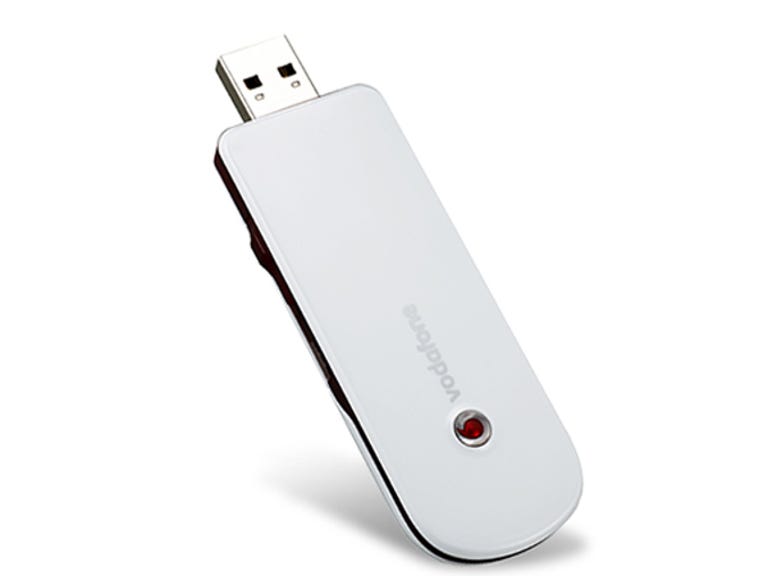 Why You Can Trust CNET
Why You Can Trust CNET Vodafone Mega Modem review: Vodafone Mega Modem
Vodafone's new modem isn't entirely mega, but it did show us the promise of better speeds than we're used to seeing out of the carrier.
Design
USB modems don't tend to vary in design that much, and Vodafone's latest offering, dubbed the "Mega Modem" isn't really that much of a standout unit in design terms. As with every USB modem on sale in Australia (save for those offered by Telstra), it's a re-badged Huawei offering, in this case the K4505. Our review sample came in a white casing with a very dark red trim; in some light you might even think it was dark brown. The K4505 doesn't use an easily lost USB cap, instead plumping for a switch on the side that pops the USB connector out. Vodafone has sold previous USB modems that did this, and our only concern here is that if the switch weakens over time, it can become tough to get the modem to plug properly into a USB port.
The Good
The Bad
The Bottom Line
Features
The real story behind the Mega-Modem isn't its good looks, however. It's the fact that it's Vodafone's first quad-band device to market for mobile broadband customers, operating on the 850/900/1900/2100Mhz bands. Vodafone's in the process of rolling out its 850Mhz network, first across major metropolitan areas. The company's coverage checker provides a map of where it has 850Mhz coverage both installed and planned, but the claim with the Mega Modem is that it'll automatically switch to the fastest available network in any case.
The Mega Modem, like most of Huawei's offerings, also supports microSD if you wished to use it as a USB storage device. Where most mobile broadband providers just tend to chuck a splash screen over the straight Huawei login interface, Vodafone has long-provided its own login software, and the Mega Modem is no exception. It's a little prettier and more detailed than the standard software, and will even show you details of the network you're currently on, even if it's not Vodafone itself.
It's no particular secret that Vodafone has had more than its share of network woes in recent times, so we were interested to note on the Mega Modem's product page that it's covered by what Vodafone calls a "30 Day Mobile Broadband Satisfaction Trial", allowing for contract cancellation within 30 days if you're not happy. Given the genuine variability of all mobile broadband services, that's quite a bold move.
Performance
Installation of the Mega Modem can be summed up in a single word, and that word is slow. On our test Windows 7 system, installation crawled along, mainly as the Mega Modem seems to install itself as many distinct devices. During our test period we accidentally plugged it into a different USB port than the one we'd originally plugged into, and had to sit through the entire detection process again, which was annoying.
Once up and running, we got to testing the Mega Modem. Because of the aforementioned switching to the "best available" network that the modem does, it's actually all but impossible to insist on using only the 850Mhz network with it. We did what we could, testing Speedtest.Net in a couple of sites around the Sydney CBD where Vodafone's own coverage-checker indicated that 850Mhz signal should be strongest, as well as testing in Hornsby in Sydney's far north, just outside the stated 850Mhz area to get a base-level test as well. Our North Sydney and Hornsby tests were indoors while our Circular Quay and Martin Place tests were outdoors, to see whether the claimed persistence of 850Mhz signal into buildings would have any marked effect.
| Location | Average Ping (ms) | Average Download (Mbps) | Average Upload (Mbps) |
| North Sydney | 73.6 | 4.09 | 1.31 |
| Circular Quay | 141.25 | 3.98 | 0.99 |
| Martin Place | 156.33 | 0.57 | 0.053 |
| Hornsby | 76 | 2.56 | 1.16 |
Conclusion
Vodafone's Mega Modem once again shows how it's possible to get entirely variable results out of mobile broadband testing. If we'd only tested in North Sydney, we'd say it was an excellent step up for a network that could adequately be described recently as ailing. If we'd only tested in Martin Place, on the other hand, we'd chalk it up to Vodafone's network remaining terrible.
The reality lies somewhere in the middle; the Mega Modem does bring with it the prospect of better quality connections, and certainly compared to more ad-hoc testing we've done with Vodafone SIMs in recent months, it does appear that things may be looking up slightly for Vodafone. The speeds we've got are still lagging behind those of market leader Telstra, but then again Vodafone's not charging the kinds of data prices that Telstra demands. This makes the Mega Modem a potentially decent buy for those who spend a reasonable amount of time in metropolitan areas under the new 850Mhz "cloud". Still, given that wonky Martin Place speed, we'd still keep the sales receipt and that thirty day cancellation policy close.



